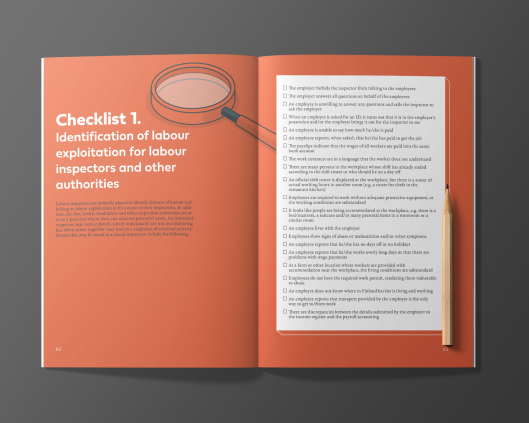How to better uncover labour trafficking? New investigation tool released for law enforcement and labour inspectors

Labour exploitation is a global problem. In many countries particularly people with migrant backgrounds are affected as offenders take advantage of their vulnerability and ignorance. The offenders not only cause suffering for the victims but also gain an unfair advantage over their competitors by disregarding laws and regulations. Furthermore, labour trafficking and exploitation are often connected to the shadow economy and financial crime. This means that the state loses tax money in the process.
“Unfortunately, labour trafficking is very lucrative to those wanting to maximize their profits because the perpetrators rarely get caught“, HEUNI Senior Programme Officer Anniina Jokinen states.
Turbulent times, such as the current COVID-19 pandemic, are especially auspicious for offenders because more people are facing uncertain times in their lives.
The phenomenon of labour exploitation and trafficking is complex and there is no easy fix for it. The authorities are increasingly responding to new instances of labour exploitation, but in addition to the hidden nature of the crime, the lack of coordination, resources and specialization make investigations difficult. Investigating trafficking cases demands special skills and expertise from the police. HEUNI partnered with the Finnish police and Labour Inspectorate for their expertise and to ensure the relevance of the investigation tool to its target user group. To uncover and address labour trafficking and exploitation, the authorities must also enhance multidisciplinary cooperation nationally as well as internationally. Armands Lubarts, Head of the Anti-Trafficking Unit in Latvia confirms that officials have encountered problems in labor exploitation investigations.
“The FLOW project investigation tool explains the problems and uncertainties related to labor exploitation, and we are committed to applying the tool into practice", Lubarts concludes.
Labour inspectors can use the checklist specifically designed for them to assess whether the workers they encounter might be victims of labour exploitation or trafficking. By compiling hands-on techniques, recommendations and how-to’s, the tool is meant for the practical use of different authorities.
“Labour inspectors and other supervisory authorities have an important role in uncovering labour exploitation. Coordinated joint inspections yield the best results, when the knowledge of different authorities is utilized", comments Labour Inspector Katja-Pia Jenu from the Regional State Administrative Agency for Southern Finland.
The new publication “Uncovering labour trafficking – Investigation tool for law enforcement and checklist for labour inspectors" was developed in the EU-funded FLOW project with partner countries Bulgaria, Estonia and Latvia. The investigation tool describes labour trafficking and exploitation in general. It also follows the progress of police investigations from start to finish. Moreover, it works as a concrete aid for coordinated and well-planned actions in effective labour trafficking investigations. In addition to English, the tool is also available in Bulgarian, Estonian, Finnish and Latvian languages and the reports have been tailored to the local context in close cooperation with national authorities.
HEUNI is The European Institute for Crime Prevention and Control, affiliated with the United Nations. For more information on the investigation tool or on the phenomenon of labour exploitation and trafficking, please contact Senior Programme Officer Anniina Jokinen, anniina.jokinen@om.fi, tel. +358 50 351 7044 or for country details contact atanas.rusev@csd.bg (Bulgaria), anna.markina@ut.ee (Estonia), and lasma.stabina@iem.gov.lv (Latvia).
